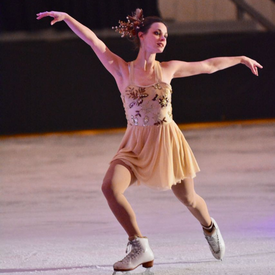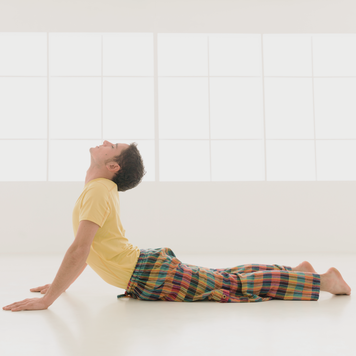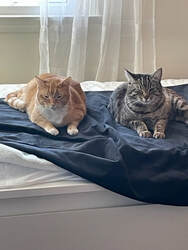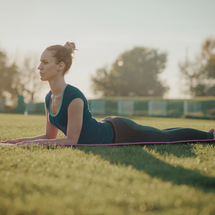|
Cobra pose is one of the most well-known poses of yoga, but if you need to improve your carriage in skating, you should practice Sphinx pose (salamba bhujangasana) instead. Carriage is the term used to refer to how a skater carries their upper body–everything from the angle of the torso in relation to the lower body, the shape and placement of the shoulders, the alignment of the head and neck, and the length and look of the arms and hands. Carriage is what makes a skater’s performance look elegant, effortless, and polished vs. labored, choppy, and sloppy. Good Carriage is a Key Component of SkatingCarriage is one of the key factors scored in moves in the field and ice dance tests. Skaters work on it beginning in Snowplow Sam when the coaches say “If you look at your toes, you fall on your nose”. Or in Basic Skills and Adult classes when coaches make skaters balance beanie babies on their hands and heads. Besides contributing to the “look” of skating, proper carriage is crucial for balance, which translates to power, flow, and edge quality, and it all goes hand in hand with extension. Good carriage is also necessary for the proper execution of many elements–not just spirals and camel spins. It’s crucial for the execution of turns and jumps, too! When a skater carries their arms too high or low, their shoulders scrunched up towards their ears, and/or the torso pitched forward, they have less control of back muscles that are crucial for stability and twisting. Finally, poor carriage can zap your stamina–when the shoulders come up and the skater starts to hunch over, the lungs don’t work as efficiently. Proper Posture is Hard to DevelopGood carriage can be very hard to develop and takes years of practice. Many skaters take years of ballet classes to help with carriage. Nathan Chen famously danced with the Salt Lake City Ballet for years as a child. Ice dancers also work on carriage during ballroom dance classes. You may have seen Dancing with the Stars contestants using the infamous curved bar around their shoulders. It helps to arch the upper back while extending the arm. But the bar is pricey and not always convenient to use at the rink, and it’s not safe for beginning skaters to use on the ice. Plus, it doesn’t fit skaters of all ages. I think skaters would run for the hills if coaches used these during Learn to Skate! Sometimes I use a velcro posture trainer that is somewhat similar to the stiffer devices often used in physical therapy, but again, I don’t always have it handy, and it’s not one size fits all. So, carriage can be hard to train. It takes relentless pursuit and countless hours because we spend our lives hunched over and aren’t used to feeling the back muscles needed to develop good carriage (specifically the latissimus dorsi, trapezius, and triceps muscles). Some skaters naturally have better posture than others–it’s just their anatomy. But there is hope for everyone because there is an easy way to start training carriage from a very, very young age. It’s sphinx pose. Why Sphinx is Better Than CobraSphinx pose is a close cousin of cobra. It is also considered a backbend and so, has some of the same benefits of all backbends:
I like sphinx pose better than cobra, though. In cobra, yogis tends to overuse the arm muscles to lift the back, often hyperextending the elbows. Also, many practitioners throw the head back and compress the cervical spine (the neck) instead of beginning the backbend from the chest. This also can lead to compression of the lumbar spine and pain in the low back, if practiced without awareness. For competitive and sometimes hypermobile yogis, like many skaters, cobra gives them an out to try to push into the deepest backbend they can do. But….. more is not always better! Because sphinx is practiced on forearms, there is no risk of hyperextending the elbows. Also, by placing emphasis on the downward contraction of the back muscles, there is less urge to lift the chin, and therefore less risk of straining the neck. Sphinx helps skaters feel and develop the muscles they need to keep the shoulders out of the ears for proper carriage and to squeeze the shoulder blades together in a spiral, camel spin, landing position, or any kind of extension. It’s also important to add that by strengthening the lattisimus dorsi, skaters can learn to support their arms from below (rather than from overworking the deltoid muscles at the top of the shoulders), which leads to less fatigue. No more complaining about their arms hurting after stroking laps or power class!!! Finally, no equipment is needed for sphinx, and it is accessible for all ages – whether measured in human years or feline years. How to Do Sphinx PoseStep-by-step instructions for Sphinx pose:
Practice Sphinx Anywhere–No Mat RequiredIn fact, this week I’ve been having my students lie on the bench in the penalty box and do it. It works like a charm for waking up the back muscles for spirals and camels! And even though I hated it in the beginning of my yoga journey, Sphinx is now one of my favorite poses. I just really needed triceps and lats work, so it didn’t feel comfortable. Now, I feel strong and steady and grounded when I practice it. I hope you feel that way, too – even if it takes practice to get there. In short... one of the most important factors in skating success is proper carriage, and yoga offers us a super simple, can-be-practiced-anywhere pose to develop the muscles and awareness for that proper carriage. Do Sphinx pose. Try it out and let me know how it goes! Looking for more ways to improve your skating and performance? Get started with my FREE GUIDE: Top Tools to Beat Performance Anxiety.
0 Comments
Leave a Reply. |
Author // the skating yogiMy name is Sarah Neal. I have been immersed in the world of figure skating for over four decades. I have seen firsthand the abuse that happens at the higher levels of our sport and experienced how that trickles down into unhealthy training practices and habits at the grassroots. I have seen this play out in the operations of the very institutions that control our sport. Whether for a profession or hobby, pursuing skating should be a joyful, rewarding process, an opportunity for athletic and personal growth, and a place to build lasting friendships. Archives
March 2024
CategoriesAll Athlete Well Being Athlete Well-Being Deep Connections Embodied Movement And Meditation Practices Life After Competition Mindful Living |
Search by typing & pressing enter





 RSS Feed
RSS Feed